Resumes share something in common with most manufactured products: that is, while the end result may look complex, it’s really just an assembly of parts. But, like building a manufactured product, knowing how to make a manufacturing resume takes skill and practice. We’ve done the hard part for you by breaking down each part of a resume sample and explaining in detail what should be included, how to format each section of your resume and other tips and best practices. Best of all, you can use our manufacturing and logistics resume builder to put each of these tips together to build a great resume without the hassle.
resume example:
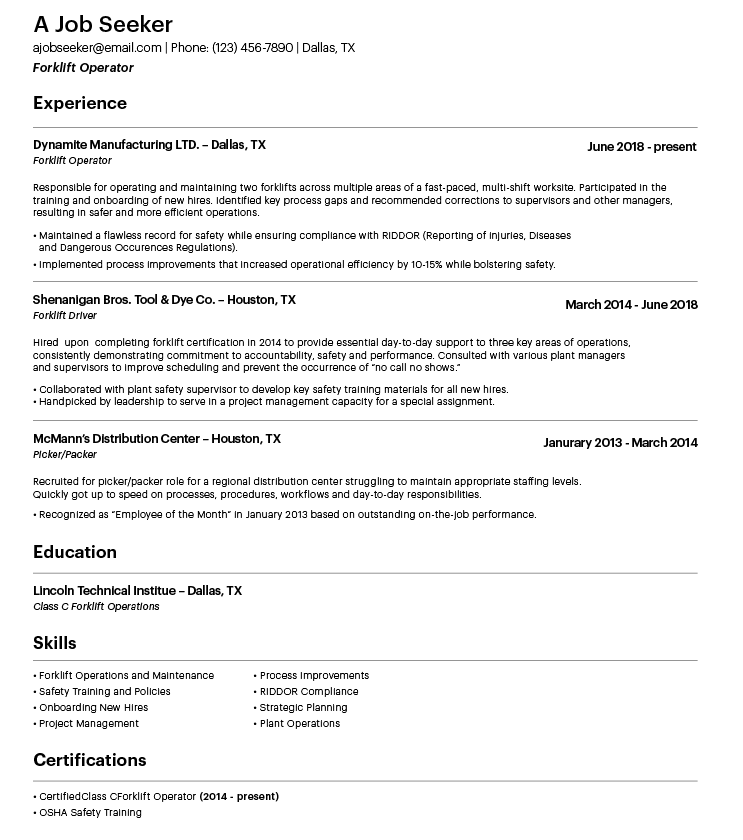
So let’s dive in, with illustrative examples at every step to help keep things concrete.
components of a manufacturing and logistics resume
1. contact information and professional title

A good manufacturing and logistics resume makes things easier for recruiters, hiring managers — and whoever else the reader might be. Start by listing your name in a large font (the above example uses Tahoma typeface, size 22). Below it, type out your email address and phone number. Note that a complete street address is no longer mandatory, in large part due to privacy concerns. Simply listing your city and state is fine.
The final piece of the puzzle: your professional title. Again, the goal is to make things obvious and immediately digestible in a single glance for your reader. Notice, too, that the title you use need not be the title you currently hold (or most recently held). But it most certainly should be the title of the role that you’re applying for. Looking to land a gig as a forklift operator, for example? Put “Forklift Operator” here.
2. employment history
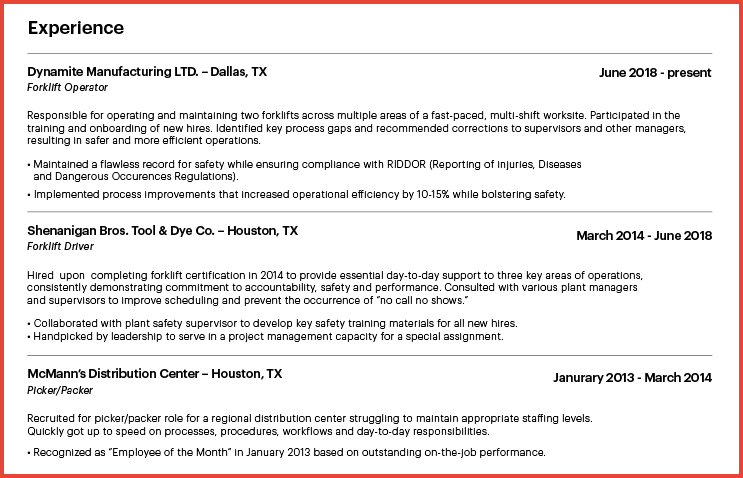
Next up: Employment history, often referred to as “Professional Experience,” or simply “Experience,” as in the resume sample above. In terms of organization, it’s important to follow a linear chronology in listing out your experience, starting with your most recent employment history and working backwards from there. Be sure to clearly indicate dates, titles and employers for every job you’ve held, going back at least 10 years, if applicable. Don’t worry too much if you have any gaps in your employment history — that’s something every recruiter has seen before, and they’re unlikely to view it negatively.
Two pointers about language in this section:
- You should write in the style known as “implied first person,” which sounds more complicated than it is. In reality, it’s just like making any other first-person declarative statement, only with the pronoun pulled out: “I went to the store,” “I walked around the block” and “I mowed the lawn,” for example, translate to “Went to the store,” “Walked around the block” and “Mowed the lawn,” respectively. This keeps things short and helps you get to the point.
- Between your job descriptions (normal typeface) and bullet points, differentiate between ordinary job responsibilities and actual achievements. And in the latter, you should quantify as much as possible, too. Doing that helps drive home the value you would bring to a prospective employer.
3. education
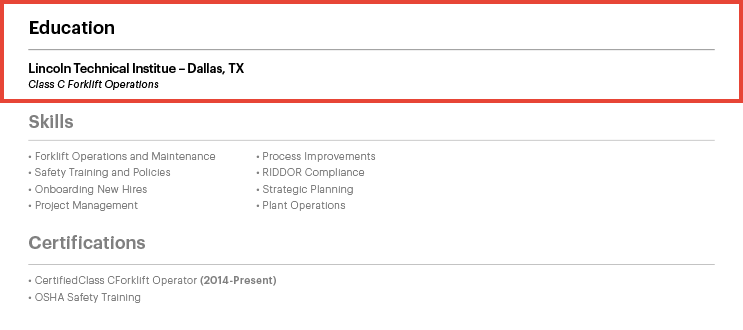
Between education, skills and certifications, the order you decide to employ on your resume isn’t all that important. What really matters is that you include them all. For education, simply list your highest level of educational attainment. At the same time, if you think other, more recent achievements — like the “Class C Forklift Operations” certification in the professional resume example — outweigh traditional educational attainment as being most relevant to a potential employer, feel free to showcase that here, as well.
4. skills
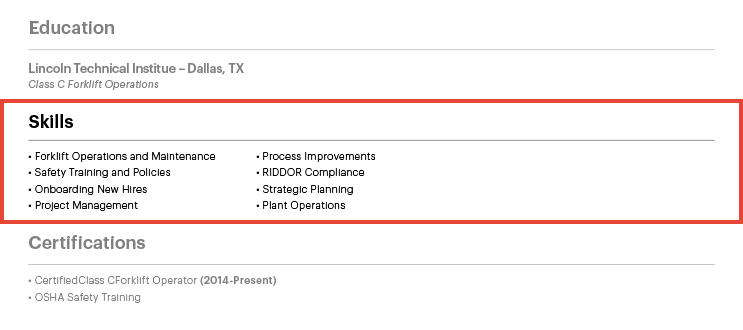
The funny thing about “skills” is that we all have many more of them than we’re probably ready to rattle off at a moment’s notice. So take your time with this section, and be sure to include soft skills, like communication and teamwork, alongside hard ones, like technical aptitudes and recognized areas of expertise.
Struggling to come up with the best and most relevant soft skills to sell your candidacy? You can plug and play with this list of 135 soft skills. That should help get your mental juices flowing. Aim to include anywhere from eight to 16 in this section.
Finally, don’t sweat the formatting when listing out your skills. As in the above example, a simple bullet-pointed, two-column layout is fine.
5. certifications
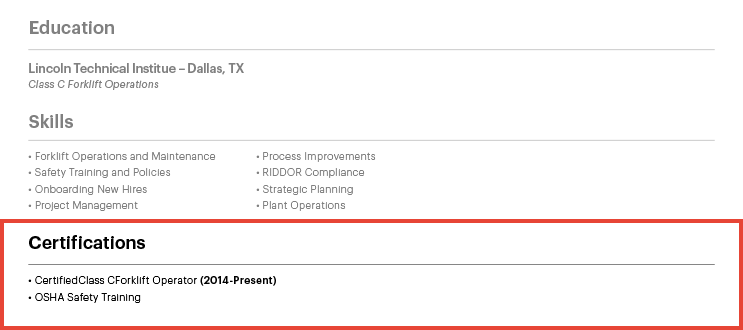
You’re almost done! The final box to check: certifications. Especially at a moment when upskilling and reskilling are so vital to employability, certifications can be a differentiator — and even take your candidacy over the finish line.
Note, however, that you don’t have to restrict yourself to certifications that you’ve formally completed. For example, if you’ve taken coursework toward OSHA certification but haven’t actually completed the full certification, that’s something you’ll nonetheless want to jot down here.
Again, you can keep things neat and tidy by using the bullet-pointed, two-column layout. And just like that, you’re done! For additional help — or simply inspiration — check out the sample resume we’ve been referring to in its entirety here.
next steps
Now that you have a clear vision of how today's top manufacturing and logistics candidates are organizing their professional experience and presenting it to employers, you should be all set to put your best foot forward, too. That said, if you need a little extra encouragement, we've got you covered as well — just head over to our free resume builder.
You'll have to provide a little bit of information: your contact info, employment history, skills and so on. But we'll handle it from there. After inputting all of your details — voila! — you'll receive a professional-looking manufacturing and logistics resume in either Microsoft Word or PDF format (your choice), which you can start sending out to potential employers. In fact, we'll even help you find jobs that seem like a match based on your resume.
You have to admit, it doesn’t get much easier than that. Plus, if you haven’t already, this is also a great opportunity to join Randstad and discover all of the ways that partnering with us can help power your career growth today.
 download resume sample
download resume sample